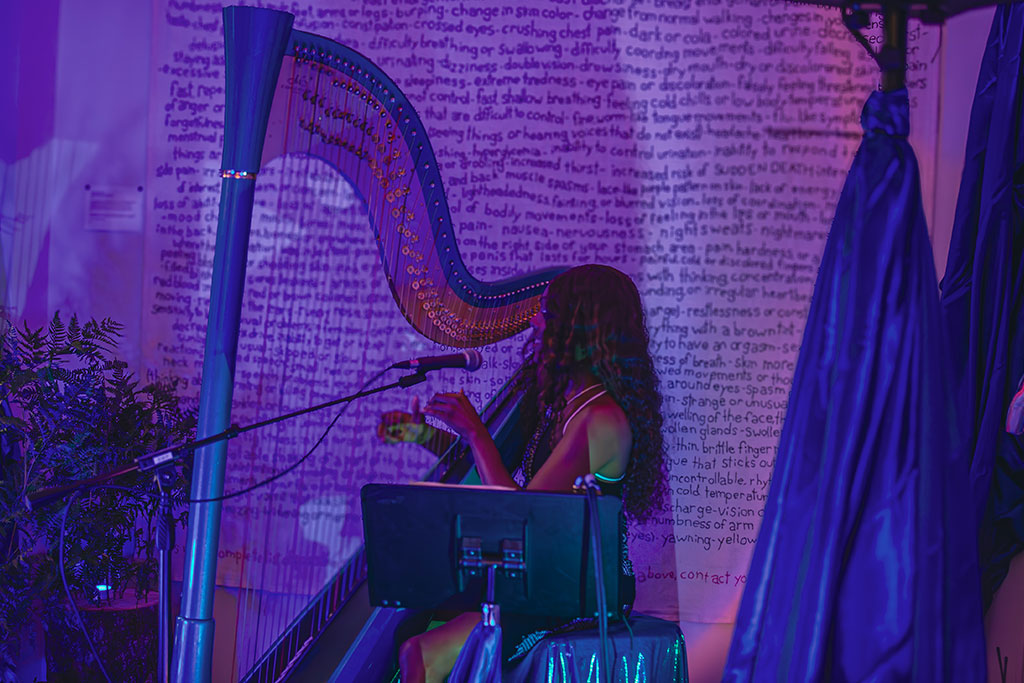UM-Flint's Riverbank Arts creates a healing space for city's queer community

If there's one thing that LGBTQIA+ folks know, it's that there is safety in numbers. That's why many migrate to larger cities or smaller queer-friendly enclaves like Ferndale in Metro Detroit, where thriving similar populations offer social and emotional support in a safe environment.
But what about a smaller city like Flint? How do like-minded folks find each other in our community? How can we build connections and create experiences that showcase Flint's diverse population? What can we do to offer spaces that heal and promote balanced mental health within the queer community and beyond?
These are the questions that Audrey Banks, a graduate arts administration student at the University of Michigan-Flint and assistant at Riverbank Arts, sought to answer as she developed Riverbank Arts' recent exhibition "Queer Resilience: Art as Liberation."
"I didn't want to simply hang art on the walls; I wanted to offer a series of events and programs that would take place throughout the exhibition," Banks said. "The gallery exhibition features 11 artists from all over Michigan and even Illinois, and I saw that as an opportunity to foster community connection. Mental health and addiction aren't topics that we talk about enough, especially in the queer community, and 'Queer Resilience' was designed as a safe space for all of us to come together and find ways to support each other."

Banks contacted Tunde Olaniran, the founder of the creative production company Magic Wheel Creative, to collaborate on the closing night event. Olaniran had previously worked with Detroit-based musician Ahya Simone and knew that Simone's explorations of sound as a healing medium would lend themselves to a powerful community experience. For her part, Simone was thrilled to be invited to perform.
"When Tunde contacted me, I was excited by the opportunity to share the work that I'm doing with a new audience and community in Flint," Simone said. "Harp is one of those instruments that can be seen as a bit classist, and I've worked hard to revitalize its reputation and show different groups that you can groove to harp, too. Communities everywhere need healing right now, and I love that I am part of creating a healing space in Flint."
At the suggestion of Hilary Murmers of UM-Flint's Center for Gender and Sexuality, Banks and Olaniran reached out to collaborate with the Crim Fitness Foundation. Crim helped expand "Healing Frequencies" to include community art-making and guided mindfulness meditation.
"It was important to all of us that the wellness activity had a low barrier of entry, something that anyone could do and that we could all share in the gallery's relatively small space," said Banks. "The Mindfulness team at Crim also had the brilliant idea of community art-making, and they brought canvases and supplies for the community, who were then encouraged to create art in response to a series of prompts. People from the whole community joined in. One of the highlights for me was when a group of local teen girls walked in off the street, they had no idea about the event, and they created art that they were excited to share with the world. They wanted it to be displayed at the gallery."

Another highlight of the "Queer Resilience" exhibition was a collaboration with UM-Flint's CGS.
"Honestly, the movie night we collaborated on with CGS was my favorite part of the program," Banks said. "It was just super intimate and helped us all forge a new community of queer folks in Flint. We screened the documentary 'Before Stonewall,' and it was such a powerful experience for all of us. Especially some of the younger LGBTQIA+ students at UM-Flint who are struggling to find their place in our community. They met with elders, allies and other queer students, and we all left feeling less isolated and alone."
And breaking down those walls — creating a space for everyone to find support and connection — is what Riverbank Arts is all about.

"We're here for the community, full stop," said Banks. "That's what we're doing each day. And not just the university; we're here for Flint. You don't have to sell your art to be an artist. You don't have to be quirky or act weird or whatever. We're all artists. No matter your major or job, art is an outlet anyone can access to bring more balance, play, and joy to their lives. We can all create together and build a deeper community through that.
"That's what we do here at Riverbank Arts, every day. And we'll keep doing it. This is your space, Flint. Come create."
"Queer Resilience: Art as Liberation" is funded by the University of Michigan Arts Initiative's Graduate Student Arts Research Grant, UM-Flint Center for Gender & Sexuality, UM-Flint Diversity, Equity & Inclusion, and co-sponsored by CRIM Mindfulness Flint.
The exhibition has been extended through the end of July. Visit Riverbank Arts, 400 N. Saginaw St, to see it today.
Related Posts
No related photos.
Kat Oak
Kat Oak is the communications specialist for the College of Arts, Sciences, and Education. She can be reached via email at katheroa@umich.edu.











